| Pages:
1
..
25
26
27
28
29
..
31 |
joseph6355
Hazard to Others
  
Posts: 144
Registered: 23-8-2017
Member Is Offline
Mood: Nitrated
|
|
Quote: Originally posted by XeonTheMGPony  | what do you consider acceptable purity?
Clean pure product behaves reliable in predictable manner! why I distill store bought acetone and other reagents. |
Pure enough so it won't spontaneously deflagrate when I'm casting it, neither it will increase its sensitivity to the point that it becomes friction
or impact sensitive like a primary.
[Edited on 19/4/18 by joseph6355]
[Edited on 19/4/18 by joseph6355]
Oh, hello!  |
|
|
roXefeller
Hazard to Others
  
Posts: 463
Registered: 9-9-2013
Location: 13 Colonies
Member Is Offline
Mood: 220 221 whatever it takes
|
|
| Quote: |
Distilling water has become tedious, and buying it is a pain in the ***, because its heavy.
|
How much picric acid are you purifying if you are complaining about its weight?
|
|
|
joseph6355
Hazard to Others
  
Posts: 144
Registered: 23-8-2017
Member Is Offline
Mood: Nitrated
|
|
Quote: Originally posted by roXefeller  |
| Quote: |
Distilling water has become tedious, and buying it is a pain in the ***, because its heavy.
|
How much picric acid are you purifying if you are complaining about its weight? |
A series of 100g charges.
I cast them into cylindrical shape with a hole in the center for the detonator.
I use it for breaking down concrete into small bits by making a 10-15 cm deep hole in it and placing the charge in there.
My father's property is full of concrete structures for some reason. He bought it as is and the previous owner couldn't tell him what they were.
I could take some pictures next time I go there.
Picric Acid isn't very soluble. I need about 1 liter of boiling water to recrystallize 70g of it.
Oh, hello!  |
|
|
greenlight
National Hazard
   
Posts: 763
Registered: 3-11-2014
Member Is Offline
Mood: Energetic
|
|
You could try this if you have enough ethanol:
"Making use of Phenol's high water solubility, and the higher solubility of dinitro and mononitroPhenol, the Picric Acid can be purified to near
analytical grade by re-crystallization from a solvent mixture of 1 volume ethanol and 2 volumes water, roughly 9ml of solvent being required per
gram of Picric Acid."
Instead of 1 litre per 70g, it would be about 600ml but it would cost more to recrystallize.
|
|
|
joseph6355
Hazard to Others
  
Posts: 144
Registered: 23-8-2017
Member Is Offline
Mood: Nitrated
|
|
Quote: Originally posted by greenlight  | You could try this if you have enough ethanol:
"Making use of Phenol's high water solubility, and the higher solubility of dinitro and mononitroPhenol, the Picric Acid can be purified to near
analytical grade by re-crystallization from a solvent mixture of 1 volume ethanol and 2 volumes water, roughly 9ml of solvent being required per
gram of Picric Acid."
Instead of 1 litre per 70g, it would be about 600ml but it would cost more to recrystallize. |
What is instead of distilling water using my hotplate, I used a stove? It would be much quicker.
Does water vapor catches metal particulates when passing through a copper or aluminum tube or is it safe to assume that it will not contain metal in
it?
Oh, hello!  |
|
|
greenlight
National Hazard
   
Posts: 763
Registered: 3-11-2014
Member Is Offline
Mood: Energetic
|
|
If its just water your distilling then that would be fine.
Im not sure about the metal contamination. Surely it would be mininal.
I just buy 4 litre bottles of distilled water from the shop for a few bucks for materials synthesis and its saves me having to distill it myself.
If your worried about contamination that could lead to unstable salts, I would just buy the distilled water and its one less thing to worry about.
|
|
|
joseph6355
Hazard to Others
  
Posts: 144
Registered: 23-8-2017
Member Is Offline
Mood: Nitrated
|
|
Quote: Originally posted by greenlight  | If its just water your distilling then that would be fine.
Im not sure about the metal contamination. Surely it would be mininal.
I just buy 4 litre bottles of distilled water from the shop for a few bucks for materials synthesis and its saves me having to distill it myself.
If your worried about contamination that could lead to unstable salts, I would just buy the distilled water and its one less thing to worry about.
|
I don't have a car, I work at mc donalds.
Its pretty common for people to cycle where I live, and the super markets aren't that far from home, but its still annoying having to cycle for 8 km
with 20kg of water on my back  . And people keep looking at me because I'm wearing a
huge backpack stuffed with things LOL. . And people keep looking at me because I'm wearing a
huge backpack stuffed with things LOL.
Anyway. Is there a straightforward way to test a sample for metal picrates?
I heard aluminum doesn't form picrates with TNP. Is that correct? If thats the case, I could use an aluminum pressure cooker and aluminum tubing to
transport the vapors into the glass container.
If there would be any aluminum traces in the water, it shouldn't react with TNP.
This should be right.
Oh, hello!  |
|
|
greenlight
National Hazard
   
Posts: 763
Registered: 3-11-2014
Member Is Offline
Mood: Energetic
|
|
I have not heard of a test for picrate. If picrate salt contamination is suspected, the bottle is not moved and the bomb squad is usually called. It
is too unsafe to open to obtain a sample and this is probably why I havent heard of a test for it.
I think you will be okay with aluminium. Tin is safe too I have read but thats it.
|
|
|
joseph6355
Hazard to Others
  
Posts: 144
Registered: 23-8-2017
Member Is Offline
Mood: Nitrated
|
|
Quote: Originally posted by greenlight  | I have not heard of a test for picrate. If picrate salt contamination is suspected, the bottle is not moved and the bomb squad is usually called. It
is too unsafe to open to obtain a sample and this is probably why I havent heard of a test for it.
I think you will be okay with aluminium. Tin is safe too I have read but thats it. |
Aluminum picrate does exist.
The book "SILBERRAD AND PHILLIPS: THE METALLIC PICRATES" says that Aluminum picrate exists and can be obtained.
I suppose it isn't readily formed and need some sort of catalyst to form and crystallize out. I'll have to dig out more to find a synthesis for this
picrate and evaluate the possibility of it forming in a solution of water.
[Edited on 21/4/18 by joseph6355]
Oh, hello!  |
|
|
ManyInterests
National Hazard
   
Posts: 966
Registered: 19-5-2019
Member Is Offline
|
|
Since I've completed my first successful picric acid synthesis recently I decided to resurrect this thread to ask some questions about my result.
Some notes. I will have to leave what I have here for a while. Like another week or so before decanting it and boiling the liquid down some more to
extract the remaining picric acid that is in the water. I will be making another picric acid today (I hope).
I followed Roscoe's PDF instructions and a YouTube video that did the same. The only issue I have is the crystal shape. As you see they're fluffy and
flat, and not the nice needle like structure that you see in some other places. Does this mean that the picric acid isn't good? Or is the crystal
shape not as important and this is still useful for detonators and other stuff?
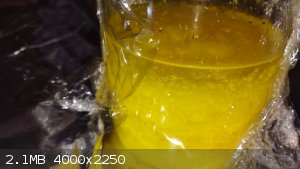 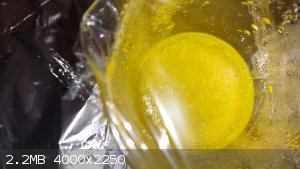
|
|
|
B(a)P
International Hazard
    
Posts: 1139
Registered: 29-9-2019
Member Is Offline
Mood: Festive
|
|
Quote: Originally posted by ManyInterests  | Since I've completed my first successful picric acid synthesis recently I decided to resurrect this thread to ask some questions about my result.
Some notes. I will have to leave what I have here for a while. Like another week or so before decanting it and boiling the liquid down some more to
extract the remaining picric acid that is in the water. I will be making another picric acid today (I hope).
I followed Roscoe's PDF instructions and a YouTube video that did the same. The only issue I have is the crystal shape. As you see they're fluffy and
flat, and not the nice needle like structure that you see in some other places. Does this mean that the picric acid isn't good? Or is the crystal
shape not as important and this is still useful for detonators and other stuff? |
Have you done a recrystallisation? Your crude product will likely look vastly different to what you get after a recrystallisation. If you want some
interesting crystals to form during your recrystallisation then insulate your vessel to allow it to cool as slowly as possible. To help determine if
you have picric acid and not the mono or di-nitrates a bit more information is required. If you followed Roscoe's PDF closely you likely have pircic
acid. I have found good temperature control and slow additions the best way to maximise your yield for this procedure, also there are a couple of
colour changes to look out for to help you know when you have reached your end points. Lower nitrated phenols have lower melting points, but the
difference is only around 15C so it may be hard to determine the melting point accurately enough with the equipment that you have.
|
|
|
ManyInterests
National Hazard
   
Posts: 966
Registered: 19-5-2019
Member Is Offline
|
|
I am confident that it is very pure picric acid (TNP) but I think it was cooled too quickly.
I made a 2nd batch today and I didn't dilute the main nitration mixture (after everything was complete) since it was already extremely liquid. I
dumped directly into a lot of ice. I did squirt 250ml of ice cold water onto it anyway. I am going to keep it in the ice for 2 hours before filtering
it.
What happened last time is that I made 50 grams of ASA starting in 225ml H2SO4 and and I used 95g of sodium nitrate. Everything went well and when I
filtered it, I recrystalized everything in 1400ml of distilled water boiled down to 400ml and I decanted the liquid while leaving the MNP and DNP at
the bottom that percipitated first as Rosco said. I did let it cool too fast. But I assume it is still good picric acid, no?
I notied that my thermometer's readings were way, way off. Good thing I have a separate thermometer to get a more accurate reading. I need to fix
that.
|
|
|
B(a)P
International Hazard
    
Posts: 1139
Registered: 29-9-2019
Member Is Offline
Mood: Festive
|
|
You are correct. Depending on your intended use, smaller crystals may be more beneficial anyway.
|
|
|
ManyInterests
National Hazard
   
Posts: 966
Registered: 19-5-2019
Member Is Offline
|
|
Well my 2nd doesn't appear to have as much yield as my first, but it could be because I used three different filter papers at first while the 1st time
I used mostly 2. I will boil down the filter water as there is more than a liter of water in there. There will be lots of stuff I could use from them.
| Quote: | | You are correct. Depending on your intended use, smaller crystals may be more beneficial anyway. |
I do want to (possibly) make a detonator with picric acid as a booster, but also to make a small charge of ammonium picrate.
In order news, my thermometer seems to peak at 92C. I don't know why it won't register higher temps, this isn't good for future picric acid synths.
Edit: Wow! I used too much water to crash the picric acid. I have 1600ml of liquid and I see LOTS of picric acid crystals shimmering within. I must
boil it down to a third ( 500ml or less) and get my crystals...
edit2: I decided to do the recrystalization as well, I added more water and I put in the wet picric acid sludge into the liquor and I am boiling it
down. I will boil it down to 400ml like last time. It'll be fine.
edit3: I realized that sometimes adding water to the nitrating mixture before crashing it might be essential. It's fine. It will only take a little
longer than normal to get the good stuff.
Also I just got Ledgard's book that people mentioned earlier. I will look through it with a grain of salt. But I did see some interesting things on
propellants in it that I might be looking into.
[Edited on 15-11-2022 by ManyInterests]
[Edited on 15-11-2022 by ManyInterests]
[Edited on 15-11-2022 by ManyInterests]
|
|
|
ManyInterests
National Hazard
   
Posts: 966
Registered: 19-5-2019
Member Is Offline
|
|
After spending a lot of time boiling down the mother liquor, and then I left it to cool overnight outside (it was 0C last night) I was left with this
crude product. (pictured below).
I spent some time boiling down the remaining mother liquor to see if I can squeeze out more crude picric acid. I am not sure if my yield is more or
less than last time, but I will need to recrystalize this stuff regardless. It might not be as much as my first time (which is still not weighed and
will remain wet for a while).
I made this batch with potassium nitrate (if I didn't mention it already) and I think it would be better if I stuck with sodium nitrate for future
synths.
Edit: I think I got almost all the remaining picric acid. There is 200ml of liquid left, and I do believe it is the left over sulfuric acid and
nitrate salt. I tried to bring it to a boil, but there was no more water left. I am chilling it in my fridge to see if I can pull out any more picric
acid. I will crash it in ice cold water after cooling it in the fridge.
Edit2: Crashed more stuff out from the acid after putting it in the fridge for more than hour (acid sure takes a long time to cool!) and I poured
around 600ml of ice cold distilled water in it. I've put it in the freezer. Going to set a timer to check on it every 30 minutes.
Edit3: Managed to get a good amount of picric acid from all this! It's good. I am doing a recrystalization. dissolved everything in 1600ml of water
and I am going to boil it down to 350ml or so before stopping the boil. All in all I am pretty proud of myself and what I've done so far!
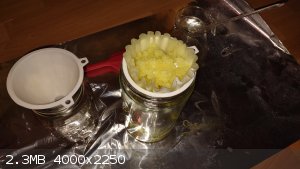
[Edited on 16-11-2022 by ManyInterests]
[Edited on 16-11-2022 by ManyInterests]
[Edited on 16-11-2022 by ManyInterests]
|
|
|
ManyInterests
National Hazard
   
Posts: 966
Registered: 19-5-2019
Member Is Offline
|
|
Might as well drop an update. My picric is stored wet currently. My 2nd batch's recrystalization was not done ideally, as I boiled the water too much
and I did not decant the acid to pour out the TNP while leaving behind the impurities. I will need a re-recrystalization.
|
|
|
XeonTheMGPony
International Hazard
    
Posts: 1641
Registered: 5-1-2016
Member Is Offline
Mood: No Mood
|
|
Slowness is the secret. All so it really doesn't like water, boiling it down super amounts really won't get you any more material, non that you'll
want anyways, all ways better to keep starting volumes as small as practical to start.
use slightly less water then called for, bring to full boil add aliquat of Piciric, some should remain, add just enough water till the remains
dissolve, it should be an active boil at this determining point
Now take container and wrap in several towels (After covering the top) better insulated the better!
Leave undisturbed till at room temp, I usually leave it a full day and night, then whilst wrapped in towel place in fridge for a day or so.
Enjoy your nice TNP crystals.
Now if adventurous, filter out and crush up crystals while damp, add in ammonia to convert to Dunnite! and from there you can make Piciramic acid, and
eventually DDNP
|
|
|
ManyInterests
National Hazard
   
Posts: 966
Registered: 19-5-2019
Member Is Offline
|
|
I left it undisturbed for a week, my 2nd batch definitely needs a re-recrystalization since I see a lot of red bits in the picric acid. I do believe
this is the stuff I don't want. It'll still have to wait before I repurify it again.
And yes I do want to make Dunnite. I did have a question for it. Would dissolving everything in 6% ammonia solution be good for making dunnite? The
ammonia is there and it is mostly water so...
|
|
|
B(a)P
International Hazard
    
Posts: 1139
Registered: 29-9-2019
Member Is Offline
Mood: Festive
|
|
Quote: Originally posted by ManyInterests  | I left it undisturbed for a week, my 2nd batch definitely needs a re-recrystalization since I see a lot of red bits in the picric acid. I do believe
this is the stuff I don't want. It'll still have to wait before I repurify it again.
And yes I do want to make Dunnite. I did have a question for it. Would dissolving everything in 6% ammonia solution be good for making dunnite? The
ammonia is there and it is mostly water so... |
You would be best to heat your picric acid before adding the ammonia solution. Make sure to add an excess of ammonia. Also note that it is somewhat
soluble in water, similar to picric acid.
|
|
|
XeonTheMGPony
International Hazard
    
Posts: 1641
Registered: 5-1-2016
Member Is Offline
Mood: No Mood
|
|
Quote: Originally posted by ManyInterests  | I left it undisturbed for a week, my 2nd batch definitely needs a re-recrystalization since I see a lot of red bits in the picric acid. I do believe
this is the stuff I don't want. It'll still have to wait before I repurify it again.
And yes I do want to make Dunnite. I did have a question for it. Would dissolving everything in 6% ammonia solution be good for making dunnite? The
ammonia is there and it is mostly water so... |
You aut to get some conversion, not sure if the heating would drive the ammonia out though, I dissolved in water then gassed in the ammonia till the
colour changed and I smelt free ammonia, then stopped the gassing and allowed to slowly cool
[Edited on 23-11-2022 by XeonTheMGPony]
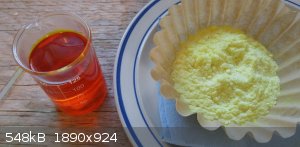
[Edited on 23-11-2022 by XeonTheMGPony]
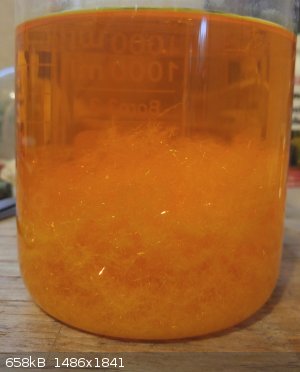
[Edited on 23-11-2022 by XeonTheMGPony]
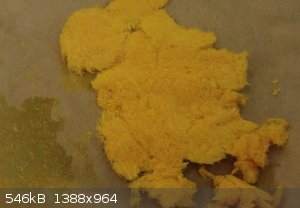
|
|
|
ManyInterests
National Hazard
   
Posts: 966
Registered: 19-5-2019
Member Is Offline
|
|
I can cover the beaker with the ammonia water in it in order to stop the gas from volatilizing. Also I want to make the red version of ammonium
picrate, not the yellow. The reason being is that when I want to make my detonator I want to see if it can detonate something as insensitive as TNT.
If it can, then I know I have a quality detonator! That's my benchmark.
Yellow Ammonium picrate is simply too insensitive and requires a compound detonator to work. I want to set something off that a detonator made to the
Improvised Munitions Guide. By that I mean (at least) 1 gram of secondary such as RDX, picric acid, or PETN (and ETN I guess) with the primary
following. For NHN I am thinking I will need at least 0.4g from here on out.
the only thing that is missing is me having a way to mechanically press my detonators, since handpressing will not achieve the proper densities
required.
I am still confused if melt-casting ETN in a cap and leaving it as is will be sufficient or if I HAVE to breakup the melt-cast ETN and grind it to
dust before filling the cap with the ETN and pressing it again. ETN should be the superior booster to either PETN or RDX due to its O-positive
balance.
|
|
|
XeonTheMGPony
International Hazard
    
Posts: 1641
Registered: 5-1-2016
Member Is Offline
Mood: No Mood
|
|
I have never heard of "red" Picric acid, what you see there is Dunnit, and it goes pop fairly well with proper initiation.
Keep practising.
When I started I made Mercury fulminate caps, then I learned compounding and studied, then it was MF 80% / Potassium Chlorate 20%.
Then as skill in chem improved I moved to 2 Stage caps, HMTD was used at 300mg (All ways better to have more of stage 1 than needed than a fissled cap
that may or may not go off seconds later!) and ETN as final stage, and even to this day it is my preferred one, once I remake my primer stocks, I will
try ETN/PTEN compounded, and may do RDX/ETN test again.
Then after many many many tests I found the smallest amount I could use based on my process for making them.
Now I make basic commercial style spec caps scaled down, then the boosters can be various types and sizes.
Focus on your detonators, once you get a good reliable system going with what you have, then move on to the next step, but IMO with out a safe
reliable firing system no point trying to make hard to fire stuff
and as you see the steel plates, that is your test, if it cuts a clean hole with minimal spalling on the bottom you got a solid system.
|
|
|
Herr Haber
International Hazard
    
Posts: 1236
Registered: 29-1-2016
Member Is Offline
Mood: No Mood
|
|
With 1 gram of RDX or ETN you will basically have a number 10 detonator which will be able to set off anything you insert it in no matter how
insensitive it is.
Ammonium picrate is *less* sensitive than TNT which in turn is less sensitive than picric acid. It was the explosive of choice for very large AP
shells. The 406mm AP shells of the Iowa class weighted 1.3 tons of which only 20 kg were Dunnite.
You dont have to break up the melt cast ETN if it's already in it's final casing of course. By the way, you mention the intention of using picric acid
as a secondary in your detonators. That is a very bad idea mostly as it will prevent you from using a metal casing and I'm pretty sure you would only
get a partial detonation from NHN / Picric acid in a plastic body.
I'm also pretty sure picric acid is a worst initiator than ETN / PETN / RDX.
When making ammonium picrate you want to be certain you are using picric acid free from impurities (leftover acids from nitration). Since you will be
boiling ammonia water, covering the beaker will simply not be enough. Best do it outside or next to a window. Prepare airtight goggles or a gas mask
to work around boiling ammonia. Really, I mean it !!! You cant just hold your breath: you need to see.
You're better off using large excess of ammonia otherwise you will end up with a mix of ammonium picrate and picric acid which depending on the
planned use might be a very bad thing. The excess gas will boil off before water so excess is not a problem.
Normal ammonium picrate looks orange just like on Xeon's picture.
I totally agree with Xeon's recommendation of making small detonators that you can insert in a booster to set off your main charge. Safety first.
The spirit of adventure was upon me. Having nitric acid and copper, I had only to learn what the words 'act upon' meant. - Ira Remsen
|
|
|
ManyInterests
National Hazard
   
Posts: 966
Registered: 19-5-2019
Member Is Offline
|
|
Yeah, commercial type detonators are interesting. they do have the primaries in one container and the booster in the 2nd. The only guide I have in
making detonators is the improvised munitions guide, which involves 1 gram of RDX or picric acid (their recommendations as there is no mention of PETN
or ETN in the book) + some amount of primary (they list many). Their way is to put the secondary, tamp it, then add the primary and tamp gently before
using a press (which is very large and almost 1.5 meters long) to mechanically press the cap to a fairly high density. I have no such press and I
don't intend to make one, hence just melt-casting the ETN and giving a good strong press by hand to the NHN (Which I've done almost 2 dozen times
without incident) should be sufficient.
I'm not likely to actually use picric acid as a booster since I have no aluminum cases to put them in, only brass (spent firearm shell cases) and
steel.
My only wish is that I had a place nearby where I can make tests for caps without noise concerns, since I do live in a densely populated area and lots
of loud bangs will attract unwanted attention.
I think when I said 'red' ammonium picrate it might have been more orange in color. I will definitely look it up once I have all the picric acid that
I want made. failed to fully purify one batch so I have a lot of work to do to make it clean and pure before I turn it into picrate.
Edit: some things I will need for the future is a good gas mask in addition to a whole lot of other equipment. I will need to wait a bit to save up
the cash for it.
One other thing for the ammonium picrate is that I do have 2 liters of 6% ammonia solution (only ammonia and water) and around 200 to 250ml of 28% lab
grade ammonia. I don't have the equipment to concentrate them to something stronger.
[Edited on 1-12-2022 by ManyInterests]
|
|
|
XeonTheMGPony
International Hazard
    
Posts: 1641
Registered: 5-1-2016
Member Is Offline
Mood: No Mood
|
|
Quote: Originally posted by ManyInterests  | Yeah, commercial type detonators are interesting. they do have the primaries in one container and the booster in the 2nd. The only guide I have in
making detonators is the improvised munitions guide, which involves 1 gram of RDX or picric acid (their recommendations as there is no mention of PETN
or ETN in the book) + some amount of primary (they list many). Their way is to put the secondary, tamp it, then add the primary and tamp gently before
using a press (which is very large and almost 1.5 meters long) to mechanically press the cap to a fairly high density. I have no such press and I
don't intend to make one, hence just melt-casting the ETN and giving a good strong press by hand to the NHN (Which I've done almost 2 dozen times
without incident) should be sufficient.
I'm not likely to actually use picric acid as a booster since I have no aluminum cases to put them in, only brass (spent firearm shell cases) and
steel.
My only wish is that I had a place nearby where I can make tests for caps without noise concerns, since I do live in a densely populated area and lots
of loud bangs will attract unwanted attention.
I think when I said 'red' ammonium picrate it might have been more orange in color. I will definitely look it up once I have all the picric acid that
I want made. failed to fully purify one batch so I have a lot of work to do to make it clean and pure before I turn it into picrate.
Edit: some things I will need for the future is a good gas mask in addition to a whole lot of other equipment. I will need to wait a bit to save up
the cash for it.
One other thing for the ammonium picrate is that I do have 2 liters of 6% ammonia solution (only ammonia and water) and around 200 to 250ml of 28% lab
grade ammonia. I don't have the equipment to concentrate them to something stronger.
[Edited on 1-12-2022 by ManyInterests] |
you generate ammonia gas directly, by ammonium sulphate being acted upon by sodium hydroxide, then heat once gas production drops.
An effective generator can be made more crudely if required but this is what I use:
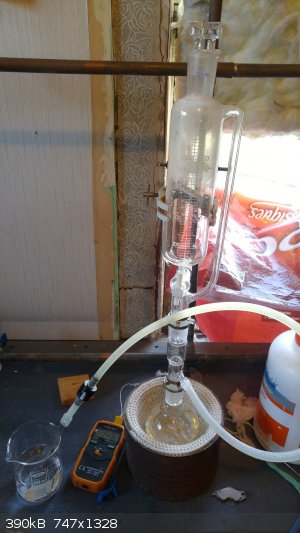
If EM is going to be your Hobby then the first thing you absolutely must have with no exception is a good distillation apparatus.
Next will be a good stirring system, makes worlds of difference
Then means of generating gasses simple enough, a non equalizing dropper funnel then the same gear above
|
|
|
| Pages:
1
..
25
26
27
28
29
..
31 |